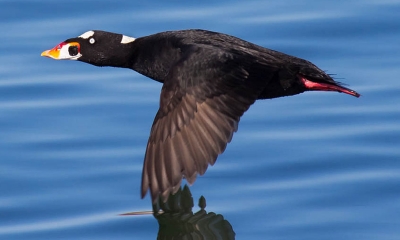
Scoters
These sea ducks move along the coasts in loose flocks and feed on mollusks, crabs, some fish and very little vegetation. A sea-duck permit is required to hunt scoters and other sea ducks.

Types of Scoters

Features: Black scoters‘ plumage is pure black uninterrupted by any white. The swollen bright orange-yellow knob on the otherwise black bill is smaller than that of other scoters. Females' uniform soot upperparts and dark head cap are clearly delineated from paler cheeks.
Habitat: This scoter can be uncommon to locally common along the coast fall through spring, usually on the ocean.
Techniques: Like other scoters, black scoters are ducks of the open ocean, and inaccessible to most hunters.

Features: Adult males' plumage is black except for white patches on the forehead and nape. The most distinguishing feature is the bill, a swollen white, red-orange, yellow, and black wedge. This highly visible standard advertises male's presence for up to a mile.
Dark-billed adult females and subadults are dark brown above and paler brown below, with two indistinct light patches on the cheeks and sometimes on the nape
Habitat: The surf scoter does not breed in Oregon but is abundant on salt water along the coast from fall through spring. Look for surf scoters in the Columbia River estuary and in Tillamook, Yaquina, Netarts and Nestucca bays. In most years, hunters west of the Cascade will report harvesting several surf scoter, with fewer reports from eastern Oregon, usually in fall on large lakes and reservoirs.
Techniques: An occasional part of a mixed duck bag. Most of these sea ducks hang out off shore where they are inaccessible to hunters.

Features: Males' plumage is entirely black except for a small white teardrop around each eye, and white secondaries that form a conspicuous square wing patch during flight. A black knob graces the males' swollen, white-ridged, orange bills.
Females and immatures are dark brown above and pale below with diffuse white patches in front of and behind the eyes. Their bills are dark.
Habitat: Abundant along the coast from fall through spring.
Techniques: Rarely taken as part of a mixed duck bag, their habit of resting and feeding on open ocean waters makes them inaccessible to most hunters.

